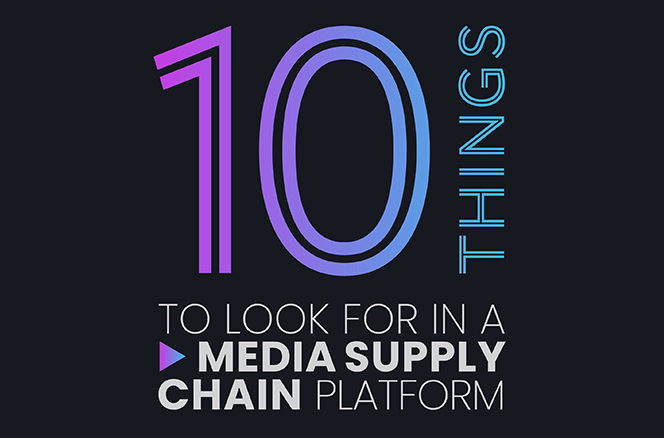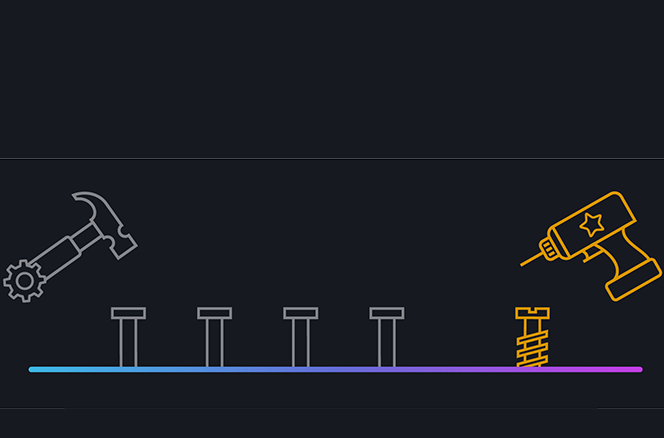Having joined SDVI just over a year ago, I thought that now would be a good time to reflect on this new world of media supply chain management. Looking back even further to the start of my career, although I didn’t know it at the time, when I first worked in broadcast operations in the early 90s, I was already deep into the world of media supply chain management.
We didn’t call it that, of course. I worked in the Traffic department. We ordered material from our suppliers. Physical tapes turned up. We transferred them to Digibeta transmission tapes. We made low-res proxies (VHS!) and sent them to language service providers who returned floppy disks with the subtitles. We barcoded the tapes and entered the timecodes into Odetic terminals for playout via robotic automation systems (very cutting edge!). A senior manager told me within weeks of my starting work as a tape librarian that tapes would be obsolete within 5 years (he was off by about 15 years).
It was a great job but fraught with human error. We once managed to miss playing out the last 10 minutes of the Friday night blockbuster movie due to mistyping the timecodes. The result was a whole primetime commercial break missed transmission, and we lost a large amount of advertising revenue.
In the early 2000s, I moved on to the world of broadcast management systems and scheduling and I was only aware of the paradigm shift from tape to file from a distance. I came across transcoders and the like infrequently and the world of timecodes and QC reports became something that informed the on-air presentation log.
So back to the here and now in 2023 and, based on what I’ve seen over the last year, I strongly believe that we are on the brink of another seismic change in media supply chain management in a way that will transform the broadcast and content production industry in the same way the shift from tape to file did.
![]() It’s become obvious that, for broadcasters and content producers delivering media, managing the supply chain efficiently is essential. Being aware of deadlines, sourcing material, and creating and distributing the product on time is pivotal to the success of the company. Miss a deadline or skip a task and, as we discovered, you risk your star show not going to air or poor-quality video or audio being transmitted. Making this process more efficient is in the DNA of every good Media Operations team, and the use of intelligent decision making to increase agility is central to their day-to-day processes. Orchestrated media supply chain management takes this accepted task-based approach and moves it in a more strategic direction.
It’s become obvious that, for broadcasters and content producers delivering media, managing the supply chain efficiently is essential. Being aware of deadlines, sourcing material, and creating and distributing the product on time is pivotal to the success of the company. Miss a deadline or skip a task and, as we discovered, you risk your star show not going to air or poor-quality video or audio being transmitted. Making this process more efficient is in the DNA of every good Media Operations team, and the use of intelligent decision making to increase agility is central to their day-to-day processes. Orchestrated media supply chain management takes this accepted task-based approach and moves it in a more strategic direction.
Traditional supply chain management involves carrying out a set of manual tasks to ensure the content is ready to be moved from one stage of processing to the next until it is finally delivered as required to the end user. Some of the challenges faced by businesses that work this way include a lack of strategic vision, a reactive approach, limited agility, and multiple inefficiencies. These can lead to missed opportunities for growth, increased operational costs, inability to respond to unexpected events, and a decline in overall productivity.
I have worked with a client over the last year whose strategic vision when it comes to media management is ‘one door in and one door out’. Working in this way involves a shift in how the business manages requirements from a project-based approach to a product-based one, i.e., from a tactical approach to a strategic one. To do this, they need to have control of the media supply chain so that they can, firstly, deliver their business needs and, secondly, gather the intelligence to become more efficient and more agile.
A manual task-based, reactive approach to media supply chain management has its limitations. Your team is constantly waiting for things to happen before they can react. Automating the tasks and linking them together enables them to plan and predict based on data. Using tools to carry out QC tasks, transcode, transcribe, and even identify objects and celebrities in video gives you information never before available at such scale and speed.
![]() Mapping out your supply chain and automating as much as you can with 3rd party systems is a great start but is limited in its overall impact. So how do you move from these incremental changes to substantial improvements? That’s where intelligent tooling comes into play. A cloud platform, such as SDVI Rally, allows you to link each of these individual tasks and orchestrate and automate when and how they happen. It enables you to scale up when needed and switch off when not. As discussed by my colleague Geoff Stedman, there is a compounding effect as you build from one task to another in a supply chain. The efficiency, agility and intelligence gained from each step informs and refines the next step increasing the benefits by more than the sum of their parts.
Mapping out your supply chain and automating as much as you can with 3rd party systems is a great start but is limited in its overall impact. So how do you move from these incremental changes to substantial improvements? That’s where intelligent tooling comes into play. A cloud platform, such as SDVI Rally, allows you to link each of these individual tasks and orchestrate and automate when and how they happen. It enables you to scale up when needed and switch off when not. As discussed by my colleague Geoff Stedman, there is a compounding effect as you build from one task to another in a supply chain. The efficiency, agility and intelligence gained from each step informs and refines the next step increasing the benefits by more than the sum of their parts.
Some real-world efficiencies I’ve recently come across were a client who linked their issue tracking system to their error handler via Rally to report issues with delivered content. Previously they would be informed of an error by email and then manually raise a ticket in the issue tracking system. This whole process is now automated, saving time and avoiding inconsistencies in data entry. Another example is the ordering and management of subtitling and dubbing. The scheduling / order system sends the requirements to Rally, and these are then processed based on rules. A language pack containing script, video and, where needed, audio stems is collated and dispatched to the Language Service Provider. Status updates are provided to Rally as the work is progressed. This removes a huge amount of manual searching, transferring, checking, and updating as the whole process is automated. Only when there is an exception does the operator need to step in and manage the process.
The traditional media operations team are well-used to being superheroes and putting out fires. Wouldn’t it be better if they could predict the likelihood of a fire starting and ensure it doesn’t happen in the first place? Any media operations veteran can regale you with war stories of ‘pulling a weekender’ to make a last-minute delivery. Wouldn’t it be great if the next generation could make that shift from firefighting to directing tasks and predicting problems?
![]() Transformation to a more connected and orchestrated supply chain ecosystem enables broadcasters and content producers to quickly anticipate opportunities and address challenges and risks before they arise. It takes the guesswork out of onboarding new delivery end points for OTT / FAST or on-demand platforms. How many assets can we process? How much does it cost? Does the deal stack up from a commercial perspective? Feeding that information back up the chain in real time helps you make intelligent decisions and transforms your ability to deliver to the company’s strategic goals.
Transformation to a more connected and orchestrated supply chain ecosystem enables broadcasters and content producers to quickly anticipate opportunities and address challenges and risks before they arise. It takes the guesswork out of onboarding new delivery end points for OTT / FAST or on-demand platforms. How many assets can we process? How much does it cost? Does the deal stack up from a commercial perspective? Feeding that information back up the chain in real time helps you make intelligent decisions and transforms your ability to deliver to the company’s strategic goals.
Being efficient, agile, and intelligent are only the initial benefits. Evolving your supply chain to the next level allows you to go from managing to directing, from reacting to predicting, and from improving to transforming. It has become apparent that simply improving your supply chain isn’t enough. Proactively managing your media supply chain will result in a transformation for your business.
—
Ready to take the first step in creating impactful change for your business? Let’s talk. SDVI is here to help.



